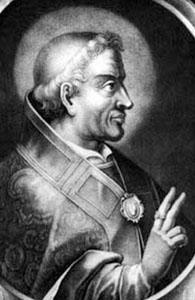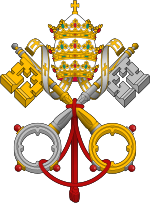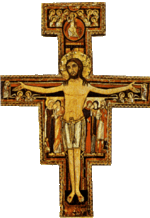Pope Agapetus I
| Agapetus I | |
|---|---|
 |
|
| Papacy began | 535 |
| Papacy ended | April 22, 536 |
| Predecessor | John II |
| Successor | Silverius |
| Personal details | |
| Birth name | ??? |
| Born | ??? Rome, Ostrogothic Kingdom |
| Died | April 22, 536 Constantinople, Eastern Roman Empire |
| Sainthood | |
| Feast day | September 20 (West) April 22 (East) |
| Other Popes named Agapetus | |
| Papal styles of Pope Agapetus I |
|
|---|---|
 |
|
| Reference style | His Holiness |
| Spoken style | Your Holiness |
| Religious style | Holy Father |
| Posthumous style | Saint |
Pope Saint Agapetus I (died April 22, 536) reigned as pope from 535 to 536.
Contents |
Biography
Agapetus was born in Rome, although his exact date of birth is unknown. He was the son of Gordianus, a Roman priest who had been slain during the riots in the days of Pope Symmachus.
He collaborated with Cassiodorus in founding at Rome a library of ecclesiastical authors in Greek and Latin, and helped Cassiodorus with the project of translating the standard Greek philosophers into Latin.
He was elevated from archdeacon to pope in 535. His first official act was to burn, in the presence of the assembled clergy, the anathema which Boniface II had pronounced against the latter's deceased rival Dioscurus, on a false charge of Simony, and had ordered to be preserved in the Roman archives.[1]
He confirmed the decrees of the council of Carthage, after the retaking of North Africa from the Vandals, according to which converts from Arianism were declared ineligible to Holy Orders and those already ordained were merely admitted to lay communion. He accepted an appeal from Contumeliosus, Bishop of Riez, whom a council at Marseilles had condemned for immorality, and he ordered Caesarius of Arles to grant the accused a new trial before papal delegates.
Meanwhile the Byzantine general Belisarius was preparing for an invasion of Italy. King Theodahad of the Ostrogoths, begged Agapetus to proceed on an embassy to Constantinople, and use his personal influence to appease Emperor Justinian I following the death of Amalasuntha.[2] To defray the costs of the embassy, Agapetus pledged the sacred vessels of the Church of Rome. He set out in midwinter with five bishops and a large retinue. In February, 536, he appeared in the capital of the East. Agapetus's attempt failed and Justinian reestablished the rights of the Empire in Italy.
The occupant of the Byzantine patriarchal see was Anthimus I, who without the authority of the canons had left his episcopal see of Trebizond to join the crypto-Monophysites. Against the protests of the orthodox, the Empress Theodora finally seated Anthimus in the patriarchal chair. When Agapetus arrived members of the clergy entered charges against Anthimus as an intruder and a heretic. Agapetus ordered him to make a written profession of faith and to return to his forsaken see; upon Anthimus' refusal, Agapetus declined to have any relations with him. The Emperor threatened Agapetus with banishment. Agapetus is said to have replied "With eager longing have I come to gaze upon the Most Christian Emperor Justinian. In his place I find a Diocletian, whose threats, however, terrify me not."[3] Justinian, for the first time in the history of the Church, personally consecrated Anthimus' legally elected successor, Mennas. Justinian delivered to the Pope a written confession of faith, which the latter accepted with the proviso that "although he could not admit in a layman the right of teaching religion, yet he observed with pleasure that the zeal of the Emperor was in perfect accord with the decisions of the Fathers".[3] There are two letters from Agapetus to Justinian in reply to a letter from the emperor, in the latter of which he refuses to acknowledge the Orders of the Arians; and there are two others: 1. To the bishops of Africa, on the same subject; 2. To Reparatus, Bishop of Carthage, in answer to a letter of congratulation on his elevation to the Pontificate.[1][4]
Shortly afterwards Agapetus fell ill and died on April 22, 536, after a reign of ten months. His remains were brought in a lead coffin to Rome and deposited in St. Peter's Basilica.
Veneration
Agapetus I has been canonised by both the Roman Catholic and Orthodox traditions. His memory is kept on September 20, the day of his deposition, in the Roman Catholic church. The Eastern churches commemorate him on April 22, the day of his death.
Sources and references
Footnotes
- ↑ 1.0 1.1 Smith, William (1867), "Agapetus (2)", in Smith, William, Dictionary of Greek and Roman Biography and Mythology, 1, Boston, pp. 59–60, http://en.wikisource.org/wiki/Dictionary_of_Greek_and_Roman_Biography_and_Mythology/Agapetus_2.
- ↑ Breviarium S. Liberati, ap. Mansi, Concilia, vol. ix. p. 695
- ↑ 3.0 3.1
 "Pope St. Agapetus I". Catholic Encyclopedia. New York: Robert Appleton Company. 1913.
"Pope St. Agapetus I". Catholic Encyclopedia. New York: Robert Appleton Company. 1913. - ↑ Mansi, Concilia, viii. p,p. 846–850
Other sources
- Louise Ropes Loomis, The Book of Popes (Liber Pontificalis). Merchantville, NJ: Evolution Publishing. ISBN 1-889758-86-8 (Reprint of the 1916 edition. English translation with scholarly footnotes, and illustrations).
| Catholic Church titles | ||
|---|---|---|
| Preceded by John II |
Pope 535–536 |
Succeeded by Silverius |
|
|||||||||||||||||||||||||||||||||||||||||||||
|
|||||||||||||||||||||||||||||||||||||||||

